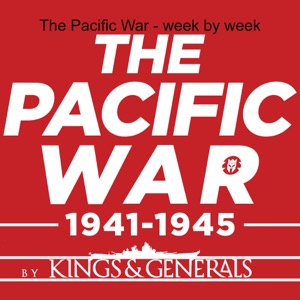- 165 - Pacific War Podcast - South China Sea Raid - January 14 - 21 , 1945
The Pacific War - week by week - Ein Podcast von kingsandgenerals - Dienstags

Kategorien:
Last time we spoke about the invasion of Luzon. As Operation Mike 1 commenced, General Swift’s 1st Corps prepared to assault Lingayen Gulf while General Griswold’s 14th Corps rehearsed at Huon Gulf. Despite successful diversionary strikes, Japanese forces anticipated an invasion. On January 2, enemy ships were spotted heading towards Luzon, confirming fears of a large-scale operation. Kamikaze attacks intensified, damaging Allied vessels, including the USS Long, which sank after being hit. Amidst bombardments, Filipino citizens demonstrated resilience despite the destruction, reflecting their loyalty and hope during the turmoil. As dawn broke on January 9, Kinkaid’s amphibious convoys approached Lingayen Gulf, initiating a fierce assault. Preceded by heavy bombardments, American forces landed on the beaches, facing minimal resistance. The 14th Corps advanced toward key locations, while the 1st Corps secured strategic positions despite enduring sniper fire. By nightfall, they established a significant beachhead. Despite sporadic Japanese counterattacks, American troops pressed forward, and reinforcements were deployed to maintain momentum. The stage was set for a crucial campaign in Luzon. This episode is the South China Sea Raid Welcome to the Pacific War Podcast Week by Week, I am your dutiful host Craig Watson. But, before we start I want to also remind you this podcast is only made possible through the efforts of Kings and Generals over at Youtube. Perhaps you want to learn more about world war two? Kings and Generals have an assortment of episodes on world war two and much more so go give them a look over on Youtube. So please subscribe to Kings and Generals over at Youtube and to continue helping us produce this content please check out www.patreon.com/kingsandgenerals. If you are still hungry for some more history related content, over on my channel, the Pacific War Channel you can find a few videos all the way from the Opium Wars of the 1800’s until the end of the Pacific War in 1945. As we last left off, the 1st and 14th Corps had just successfully established a beachhead on Lingayen Gulf. On January 11, General Krueger further reinforced his position by landing additional reserves, aiming to effectively confront the formidable enemy forces entrenched in the eastern hills. Concurrently, Admiral Halsey’s 3rd Fleet units made their entrance into the South China Sea to execute an ambitious raid known as Operation Gratitude. This operation was prompted by misleading intelligence reports suggesting that the hybrid battleship-carriers Ise and Hyuga were stationed in Cam Ranh Bay. In response, Halsey ordered Admiral Bogan’s Task Group 38.2 to launch an assault on these supposed targets. This task group was primarily composed of the battleships New Jersey and Wisconsin, which were directed to bombard the bay and eliminate any Japanese vessels that had sustained damage from prior airstrikes. To enhance their operational capabilities, Halsey established Task Group 38.5, specifically designed for night operations, which included the night-capable carriers Enterprise and Independence. On January 12, aircraft from these carriers were deployed for a predawn reconnaissance mission over Cam Ranh Bay and its adjacent waters in search of enemy targets. Despite their efforts, the search yielded no results, indicating that the earlier intelligence had been inaccurate. Nevertheless, all three carrier groups proceeded with their planned strikes at 07:30, while the surface action group advanced toward Cam Ranh. Halsey’s strategic gamble proved to be remarkably successful. Although the Ise and Hyuga were not present in the bay, American aviators discovered a wealth of enemy shipping, including three significant Japanese convoys. Sherman’s TG 38.3 encountered the most valuable target off Qui Nhon north of Cam Ranh. This was convoy Hi-86 with nine merchants and a heavy escort. The convoy had departed Cape St Jacques on January 9 a

